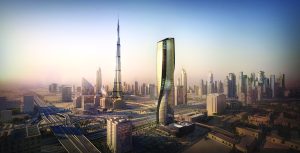DUBAI/ WAM
The 64-storey Wasl Tower is set to be one of the world’s tallest buildings to use ceramic fins as a renewable means to achieve energy efficiency, amid preparations to host the upcoming global climate summit COP 28 in the UAE.
Aligned with the Year of Sustainability being marked by the UAE this year, the new building further enhances Dubai’s credentials as a global leader in adopting state-of-the-art sustainability solutions in the construction sector.
Slated to be completed by Q3 2024, Wasl Tower’s use of ceramic fins interprets traditional renewable construction material in an innovative way – linking the past, present, and future. The tower will stand 302 metres tall when complete.
Hesham Abdullah Al Qassim, CEO of Wasl Group, said, “The construction sector is responsible for more than one-third of global annual greenhouse gas emissions. Wasl Tower represents our continuous efforts to innovate and create smarter, more sustainable developments that meet the evolving needs of people and the UAE’s climate goals.”
The fine lace of inclined ceramic fins on the building’s facade, made from hybrid elements of clay and low-tech glazed ceramic mounted in an aluminum casing, will provide shade, boost wind-induced cooling and indirectly channel daylight deep into the building’s interior.
The massive mixed-use project spanning a built-up area of around 167,733 square metres is being developed by Wasl. It will feature apartments, offices, restaurants, a luxurious 259-key Mandarin Oriental hotel and a swimming pool. The building’s twisting architectural form will make for a striking sight while fulfilling contemporary requirements for safety, sustainability and energy efficiency.
The architectural template for Wasl Tower developed by the lead design consultant UNStudio is aligned with the engineering and sustainability concept of lead engineering consultant Werner Sobek.
Solar thermal panels facilitate hot water access, while bronze-coated reflective glazing offers extremely good thermal performance, which together with the ceramic fins lowers cooling loads, significantly reducing overall energy consumption, thus promising higher comfort for occupants. Passive facade design and lighting control combine to reduce perimeter zone lighting energy by 40%. An integrating heat pump system further contributes to significantly reducing power consumption and the tower’s carbon footprint.
Ben van Berkel, Founder and Principal Architect at UNStudio, said, “Working together with Wasl, we are bringing sustainability into the business – and cultural heart of Dubai. To prioritise the health and well-being of guests and residents, Werner Sobek and UNStudio have used clean and recycled materials and finishes that enhance comfort and user experience.
Moreover, a clear spatial setup, aided by technology, ensures people can easily orientate themselves. These measures, along with precisely planned public levels and group amenities, reflect Wasl Tower’s holistic, people-centred approach to sustainable development.”
The combination of outdoor landscaping, vegetation and passive systems will translate into a comfortable outdoor microclimate. A carefully controlled acoustical environment shelters the interior from both exterior noise intrusion and internally generated noise, while grey return water aids irrigation in landscaped areas.
The tower’s geometry, achieved through parametric design and high-tech engineering, enables several sustainability measures to be implemented. A smart structural concept leads to a highly efficient floorplan while the unique architecture ensures wind loads are reduced by 20 percent. Then again, slender structural components save building materials, resulting in greater sustainability.
 The Gulf Time Newspaper One of the finest business newspapers in the UAE brought to you by our professional writers and editors.
The Gulf Time Newspaper One of the finest business newspapers in the UAE brought to you by our professional writers and editors.
